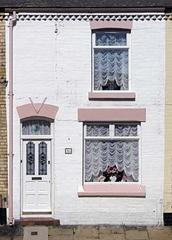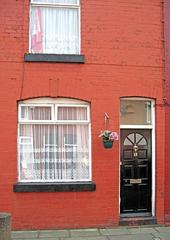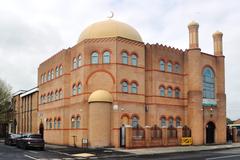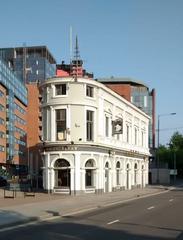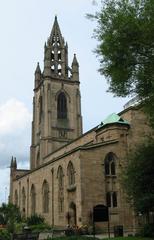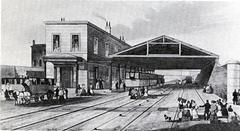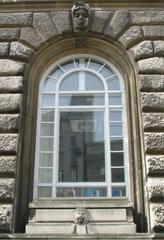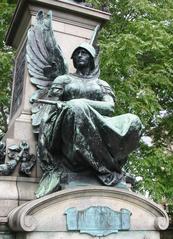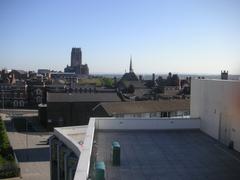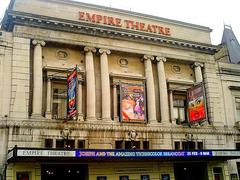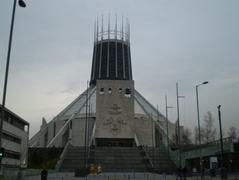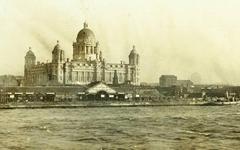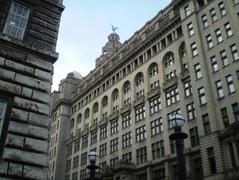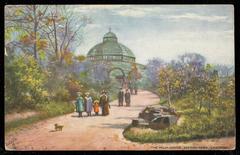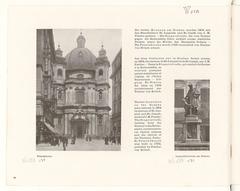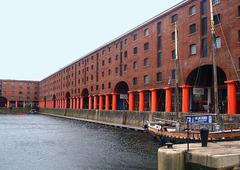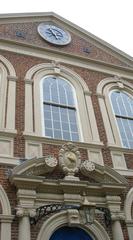St John’s Gardens Liverpool: Visiting Hours, Tickets, and Historical Sites Guide
Date: 04/07/2025
Introduction
St John’s Gardens is a distinguished green oasis in Liverpool’s vibrant Cultural Quarter, offering a harmonious blend of natural beauty, rich history, and a striking collection of monuments that embody Liverpool’s civic pride. Established in 1904 on the former burial ground of St John’s Church, the gardens have evolved from rural heathland into a formal public space, providing urban respite and commemorating notable figures and events from Liverpool’s past. Visitors can explore statues honoring influential citizens like William Rathbone, William Ewart Gladstone, and Alexander Balfour, alongside memorials reflecting the city’s military and philanthropic legacy.
The gardens also serve as a dynamic venue for public events, remembrance ceremonies, and contemporary art installations, such as their involvement in the 2025 Liverpool Biennial festival themed “BEDROCK,” which explores Liverpool’s geological and social foundations. Adjacent to iconic landmarks including St George’s Hall, the Walker Art Gallery, and the World Museum, St John’s Gardens is accessible year-round from dawn until dusk, with free entry and facilities that ensure inclusivity for all visitors. Whether drawn by a love of history, art, or a need for tranquil retreat, St John’s Gardens offers a multifaceted experience that resonates with diverse interests. For detailed visitor information, consult official resources such as the Liverpool City Council and Liverpool Biennial 2025.
Table of Contents
- Introduction
- Visiting Hours and Tickets
- Travel Tips and Accessibility
- Highlights and Attractions
- Civic Role and Urban Context
- Venue for Public Events and Festivals
- Symbolism and Social Foundations
- Accessibility and Community Engagement
- Green Sanctuary in the Urban Core
- Integration with Liverpool’s Cultural Offer
- Visitor Information
- Events and Guided Tours
- Visitor Amenities
- Practical Tips for Visitors
- Frequently Asked Questions (FAQ)
- Visuals and Media
- Conclusion
- References
Visiting Hours and Tickets
St John’s Gardens is open to the public year-round, typically from dawn until dusk. There is no entrance fee, making it an accessible and budget-friendly destination for all. No tickets are required for general entry, though special events or guided tours may require advance booking.
Travel Tips and Accessibility
Location:
St John’s Gardens is located on St John’s Lane, adjacent to William Brown Street, and within walking distance of Liverpool’s major cultural institutions.
Getting There:
- By Train: Liverpool Lime Street Station is only a 5–10-minute walk away.
- By Bus: Numerous routes serve William Brown Street and the surrounding area.
- By Car: Several public car parks are nearby, though public transport is advised due to limited parking.
Accessibility:
The gardens are wheelchair- and pram-friendly, with paved, step-free pathways and gently sloping terrain (Pacer Parks). Benches are placed throughout for rest, and clear signage aids navigation for all visitors.
Highlights and Attractions
Historical Overview
Originally used as rural heathland and later as the burial ground for St John’s Church (from 1767 until 1865), the site has witnessed Liverpool’s dramatic urban transformation. The church was demolished in 1898, and the present gardens were designed in 1904 as a formal green space, aligning with Victorian ideals of urban well-being and commemoration (Historic Liverpool).
Monuments and Memorials
St John’s Gardens is renowned for its Grade II listed statues and memorials, which collectively tell the story of Liverpool’s civic and social evolution:
- William Rathbone Statue: Honors the philanthropist and social reformer, with a statue by George Frampton (1905).
- William Ewart Gladstone Memorial: Commemorates Liverpool-born former Prime Minister, sculpted by Sir Thomas Brock (1904).
- Alexander Balfour Statue: Celebrates the businessman and philanthropist, by Albert Bruce-Joy (relocated to the gardens in 1904).
- James Nugent Memorial: Pays tribute to the Catholic priest and social reformer, with a bronze statue by F.W. Pomeroy (1906).
- Hugh Stowell Brown Statue: Portrays the Baptist minister known for his advocacy of temperance and education, by Benjamin Creswick (1889).
- King’s Liverpool Regiment Monument: A war memorial by William Goscombe John, featuring Britannia and commemorating the regiment’s campaigns.
- Steble Fountain: An ornate cast-iron fountain serving as a decorative centrepiece.
Informative plaques throughout the gardens provide historical context (Liverpool Echo).
Special Features
- Memorial Trees: Dedicated to Liverpool icons like John Lennon and George Harrison.
- Photography: The gardens’ terraced layout, flower beds, and monuments offer fantastic photo opportunities, especially in spring and summer.
Civic Role and Urban Context
Situated behind St George’s Hall and adjacent to William Brown Street, St John’s Gardens is integral to Liverpool’s “Cultural Quarter,” a hub of museums, galleries, and libraries. The gardens provide a tranquil counterpoint to the grandeur of neoclassical architecture, serving as connective tissue within the city’s cultural landscape (Historic Liverpool).
Venue for Public Events and Festivals
St John’s Gardens hosts an array of public events, including:
- Remembrance Services: Especially around Armistice Day, with ceremonies at the war memorials.
- Civic Celebrations: Events marking royal occasions and city anniversaries.
- Art Installations: As a key site for the Liverpool Biennial, the gardens feature contemporary outdoor artworks, with the 2025 festival exploring the theme “BEDROCK” (Liverpool Biennial 2025; Liverpool Museums).
Symbolism and Social Foundations
The gardens’ transformation from churchyard to public space mirrors Liverpool’s journey from medieval township to modern metropolis. The 2025 Liverpool Biennial’s “BEDROCK” theme uses the gardens as a focal point for exploring heritage, identity, and social values, with the city’s sandstone foundations serving as metaphor (Liverpool Biennial 2025).
Accessibility and Community Engagement
St John’s Gardens is designed for inclusivity, with paved paths, seating, and open lawns. Community engagement is fostered through educational programs, guided tours, and family activities—particularly during major events like the Biennial (Liverpool Biennial Learning).
Green Sanctuary in the Urban Core
The gardens are a vital green space, supporting biodiversity, improving air quality, and enhancing urban sustainability. They provide a model for integrating green sanctuaries within dense historic city centers.
Integration with Liverpool’s Cultural Offer
With immediate proximity to the Walker Art Gallery, Central Library, and World Museum, St John’s Gardens is an essential part of Liverpool’s cultural circuit. Visitors can easily combine a garden stroll with museum visits and cultural programming (Liverpool Museums).
Visitor Information
Visiting Hours
Open year-round from dawn until dusk. No ticket is required for entry.
Tickets
General entry is always free. Special events or tours may require advance booking or a fee.
How to Get There
Located behind St George’s Hall, the gardens are a 5–10-minute walk from Liverpool Lime Street Station. Numerous bus lines serve the area, and public car parks are nearby.
Best Times to Visit
Spring and summer offer the most vibrant floral displays. Visiting during festivals like the Liverpool Biennial enriches the experience.
Accessibility
Fully accessible to wheelchair users and families with strollers. Assistance dogs are welcome.
Nearby Attractions
- St George’s Hall: Guided tours and exhibitions.
- Walker Art Gallery: Exceptional art collections.
- Liverpool Central Library: Architectural and literary interest.
- World Museum: Natural history, science, and world cultures.
Events and Guided Tours
Occasional guided tours are available through local operators such as Rogers Liverpool History Tours and mobile apps like GPSmyCity. The gardens also host civic ceremonies and remembrance services.
Visitor Amenities
While the gardens lack cafés or restrooms, Liverpool Central Library and nearby shopping centers offer these facilities. Benches throughout the gardens provide comfort for all visitors.
Practical Tips for Visitors
- Weather: Pack a light jacket or umbrella due to Liverpool’s changeable climate.
- Quiet Times: Weekday mornings or late afternoons are typically quieter.
- Photography: The gardens and Victorian architecture offer excellent opportunities.
- Combine Your Visit: Take advantage of the gardens’ proximity to major cultural landmarks (VisitLiverpool).
Frequently Asked Questions (FAQ)
Q: What are the opening hours?
A: Daily from dawn until dusk, year-round.
Q: Is there an entrance fee?
A: No, entry is free.
Q: Are guided tours available?
A: Yes, occasionally through local tour operators and via self-guided mobile apps.
Q: Is the site wheelchair accessible?
A: Yes, there are paved, step-free pathways.
Q: What are the best times to visit?
A: Spring and summer for floral displays; during festivals for cultural events.
Visuals and Media
- High-quality images of flower beds, monuments, and architecture with alt text like “St John’s Gardens Liverpool Victorian Monuments”.
- Maps showing the gardens in relation to Liverpool Lime Street Station and nearby attractions.
- Links to virtual tours and video walkthroughs.
Summary and Encouragement to Visit
St John’s Gardens is more than a public park—it’s a living monument to Liverpool’s historical layers and civic values. Free and accessible year-round, the gardens offer a peaceful sanctuary adorned with Victorian architecture and significant memorials. Their transformation from a former burial ground to a celebrated green space illustrates Liverpool’s resilience and commitment to well-being and cultural identity.
Excellent accessibility, nearby amenities, and a rich program of guided tours and educational activities enhance the visitor experience. Whether exploring the King’s Liverpool Regiment Monument, enjoying seasonal flower beds, or attending civic ceremonies, St John’s Gardens offers a rewarding and multifaceted visit. Plan to visit in spring or summer for vivid floral displays, or during cultural festivals to see the gardens at the heart of Liverpool’s artistic life. For updates and enhanced experiences, download the Audiala app and follow Liverpool tourism platforms on social media (VisitLiverpool; Liverpool City Council).
References
- Liverpool City Council
- Historic Liverpool
- Liverpool Echo
- Rogers Liverpool History Tours
- Liverpool Biennial 2025
- Liverpool Museums
- Pacer Parks
- VisitLiverpool
